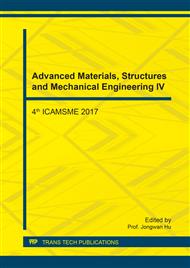p.3
p.9
p.14
p.20
p.26
p.32
p.37
p.42
p.48
The Analysis of Thermal Characteristics of Carbon Containing PET Surface Element According to the Area Density and Electrode Shape
Abstract:
The temperature uniformity of most carbon fiber is degraded on the entire area. Therefore, understanding the thermal characteristics based on surface density and electrode shape becomes necessary. In this paper, the samples were fabricated according to the area density of carbon fiber and polyethylene terephthalate (8.8 g/m2, 20.2 g/m2, 42.1 g/m2). Different voltages (2V, 4V, 6V) were applied on them and the image was taken using thermal camera. Initially, the samples were investigated for morphology and element characterization by SEM-EDAX of surface heating elements and found that increased area density resulted in increase in the number of carbon atoms and decrease in number of oxygen atoms. It was also found from sheet resistance test that area density has inverse proportional relation with sheet resistance. In addition to that, regardless of the shape of the electrode, the increase in area density leads to a rise in temperature. It also increased the range of the temperature variation. Therefore, the uniformity and temperature stability can be satisfied by securing the electrode part as wide as possible through uniform electrode shape. In case of homogeneous electrode type, the saturation time of maximum temperature was 270 seconds, and the loading time was longer than 70 seconds of the concentrated electrode type. Therefore, in order to satisfy the reference temperature (30°C~ 50°C), the required surface heating product should be manufactured with the area density of 20.2 g/m2 at a voltage applied around 6V or less.
Info:
Periodical:
Pages:
26-31
Citation:
Online since:
November 2017
Authors:
Price:
Сopyright:
© 2017 Trans Tech Publications Ltd. All Rights Reserved
Share:
Citation:


